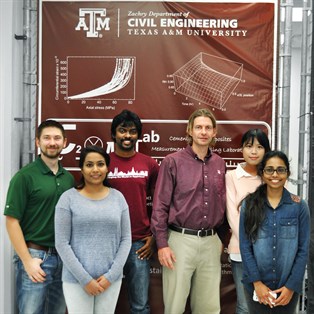A society’s socio-economic status depends on the quality of its infrastructure. All of those highways, buildings, and power supplies are structures enabling the technological growth of our society. We all utilize this infrastructure, and we all pay for this infrastructure. If we are paying for this, we want it to last. Beyond lasting, we want it to not require lane closures and detours that cause us to sit in bumper-to-bumper traffic, wasting time and money.
The majority of this infrastructure is concrete – something we use so much of that it is impossible to substitute another material class for it. There are simply not enough elements in the Earth’s crust to satisfy our demands for infrastructure. While concrete is the most used material in the world after water, what ensures its performance is the key ingredient – the cement paste holding it together. It is this key ingredient that can be improved upon to extend the life of the concrete, saving billions of dollars in maintenance and construction.
Research on cement longevity is underway in the Zachry Department of Civil Engineering at Texas A&M University. Dr. Zachary Grasley, associate professor and Peter C. Forster Faculty Fellow I, recently had his paper on the subject published, and recognized as an outstanding paper for 2015, in Materials and Structures.
“Making concrete more durable and resilient has enormous societal impacts,” said Grasley. “It will lessen the pressure on finite natural resources needed to meet our growing demand for concrete infrastructure. The models we create help us to understand how and why concrete deforms the way that it does, which gives us insight into how to better engineer its performance.”
His research is a combined experimental and modeling approach rooted in fundamental sciences and aimed at improving concrete infrastructure in the United States and around the world. It involves new material development, novel experiments to measure important properties related to durability and resiliency, and advanced models to uncover mechanisms and predict performance of concrete in real structures.
“Viscoelastic materials are like the Tempur-Pedic mattress,” said Grasley. “Those materials have a couple of very important characteristics. One is the ‘elastic’ part of that term. It’s reversible, recoverable, and goes back to the way it is supposed to do that. The ‘visco’ part of that term means it comes back slowly. If you leave a column sitting on a concrete surface, gradually you will see that surface sink under the weight over time. If you can tailor those properties, you can reduce the stress on your concrete, meaning less repair is necessary.”
Materials with tailored viscoelastic properties can better absorb an impact or force. Moving forward, if concrete is designed with specific viscoelastic properties, it may delay or even prevent damage from taking place, thereby saving a great deal of money on repair and maintenance.
 The new materials, experiments and models Grasley’s group is developing will ultimately have wide-ranging applications. They may one day be used for 3-D printing of structures or structural elements or rapid repairs of infrastructure. The experiments could be used for quality control or quality assurance to help improve concrete durability in pavements and bridges. The models may one day be integrated into a design and analysis tool that allows optimized simultaneous structure and material designs.
The new materials, experiments and models Grasley’s group is developing will ultimately have wide-ranging applications. They may one day be used for 3-D printing of structures or structural elements or rapid repairs of infrastructure. The experiments could be used for quality control or quality assurance to help improve concrete durability in pavements and bridges. The models may one day be integrated into a design and analysis tool that allows optimized simultaneous structure and material designs.
From a materials development perspective, Grasley is currently working on developing rapid hardening concrete intrinsically reinforced with carbon nanofibers. The goal would be a crack-resistant concrete that gains strength fast enough to be utilized in minutes rather than days. He has developed a novel, rapid test for measuring concrete permeability, which quantifies how easily water or other liquids can flow through concrete, which is actually porous like a sponge. With respect to modeling, he has worked on advanced material models that couple the evolution of the material structure, which changes as cement chemically reacts with water, with material response to the environment and external loading. His is the first research group to develop a method to adequately disperse high-volume fractions of carbon nanofibers in a cementitious matrix. His research has led to the discovery of new mechanisms of creep — gradual deformation that occurs under constant load — and drying shrinkage.
Grasley’s research makes an impact outside his own field of study. Because his research is based on fundamental science rather than empiricism, the models and experiments he has devised have far reaching applications outside of civil engineering. His work with a former Ph.D. student led to the creation of a novel quantification method on how well dispersed nanoparticles are within a composite material. This method is so general that it may be adopted to quantify how well crops are dispersed in a field, or how well dispersed stars are in the sky, the potential applications are limitless. It is impossible to predict where such research might ultimately be utilized.